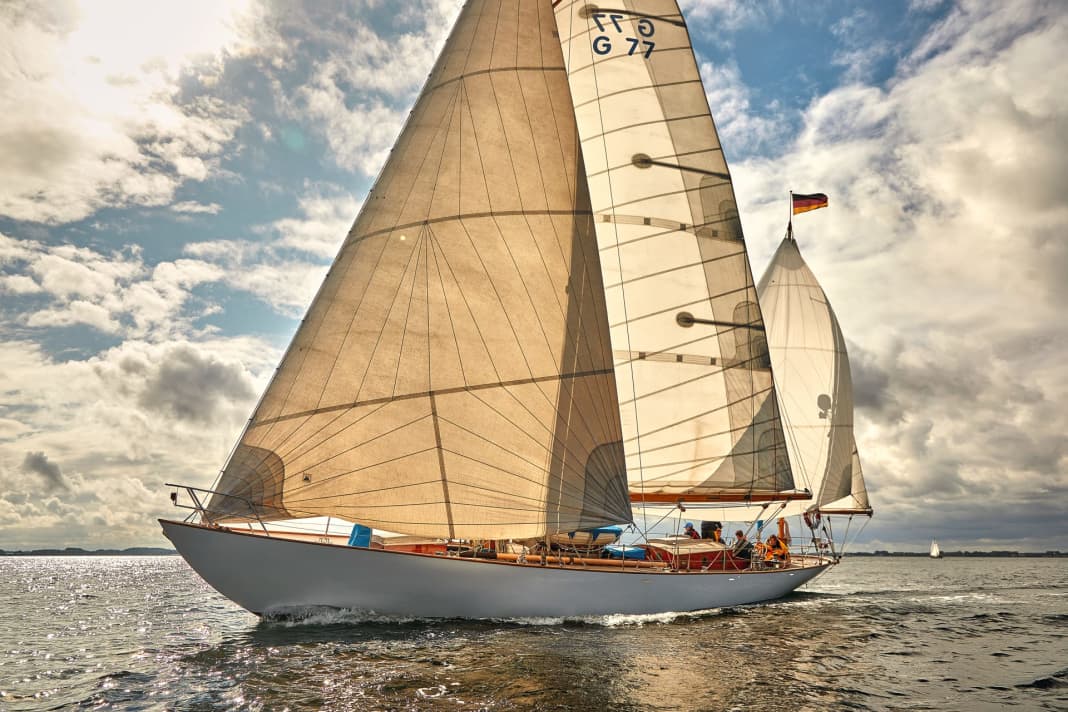





Oilskin weather. And in a calm. The air is heavy with moisture over the Schlei on this summer's day. The crew of the ocean-going yawl "Peter von Seestermühe" prepares to set sail from Grauhöft near Kappeln. In early summer, the prominent classic sailed across the Atlantic for the 40th time. Today it's time for a cruise, but owner Christoph von Reibnitz makes sure that even that doesn't get boring. "I can't turn on the engine for one boat length, I can't do that!", he introduces the manoeuvre briefing and explains how the 30-tonne displacement ship is to be towed by hand and manoeuvred out of the box and that it is important to act quickly so that the cross-current does not lead to a mishap.
The manoeuvre works without a word. Barely out of the box, 165 square metres of sail rise up the masts, and then the imposing classic slowly picks up speed and dives into the picturesque natural landscape of the Schleim estuary.
In addition to miles on the high seas that can hardly be counted, moments like this keep alive what makes up the soul of the "Peter": its creation in record time on the initiative of Gdansk students who wanted to take part in the 1936 transatlantic race. An adventurous rescue after the war and a new start in the Kiel Academic Sailing Club (ASV). Tough years as a training yacht on almost uncountable and multiple award-winning ocean voyages up to participation in the first race around the world. Numerous conversions, gradual decay and then, 30 years ago, the enthusiastic rescue by the current owner, who has gradually restored his ship to a piece of jewellery and sails in the spirit of her builder.
The "Peter von Danzig" is for sale in summer 1991
Von Reibnitz took over in the summer of 1991. The ASV offered its 55-year-old flagship as an "Atlantic-tested 150-sqm yawl, without engine, ready to sail with various accessories". Price VHS. The reasons were no secret at the time. "The running costs incurred by such an old ship, but above all the expenses for the steel work now required on the hull, can no longer be borne by the association," the chairman is quoted as saying by YACHT.
Von Reibnitz has archived the newspaper article, as well as everything printed about his ship that he could get hold of. He has spread the archives out in front of him on the high-gloss back in the brand-new saloon - the new extension has taken him and his helpers the whole winter.
The owner has long dreamed of adapting the interior back to the original layout and yachting style of the year of construction. Now it smells of fresh paint, the leather-covered saloon sofas look untouched, and von Reibnitz first has to get used to his new home. Last but not least, the past winter is still in his bones. A time that has reminded him of the early days, when he took over the ship in a condition that can only be described as "ready to sail" with a great deal of goodwill.
To prepare the steel Yawl for travelling with paying guests, the then 25-year-old brings her from Kiel through the Kiel Canal across the Elbe to Wedel. He found accommodation in Schnalle's harbour, a biotope of individualists and their boats. The boy from Seestermühe is ridiculed by the established sailors in his home area, the Lower Elbe. "Only a few very good friends believed in the project," he recalls, who at the time had the enthusiastic idea of living on and from the ship in the future.
But von Reibnitz is not deterred. For nine months, the enthusiast worked to the point of exhaustion on the complete renovation of his new love when he wasn't sleeping. It is a time when ships like the "Peter" are not considered classic, but old. Von Reibnitz is one of the few who consider them timeless. He lays a teak deck, installs the first engine and overhauls the interior to offer his guests a minimum level of comfort.
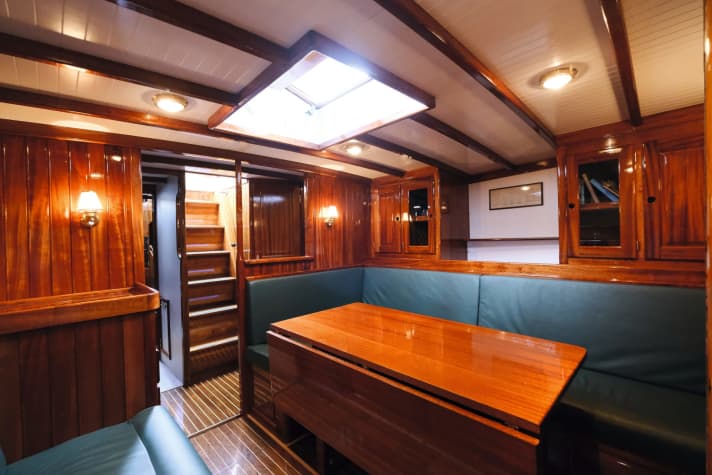
Looking back, this period marks the beginning of the second life of a yacht whose future existence was hardly believed by anyone other than its owner at the time. And this rebirth is reminiscent of the history of the "Peter von Danzig". This was also characterised by idealism and an enthusiastically pursued idea.
The year was 1936 and the idea of a transatlantic feeder regatta to the Olympic sailing competitions off Kiel was born. A group of students from the Academic Sailing Club of the then free city of Gdansk formed to take part. What they lack is a suitable ship. The "Peter von Danzig" was to be launched shortly afterwards. A 17.90 metre long and 4.16 metre wide ocean-going yacht made of steel, rigged as a Bermuda yawl, with an upwind sail area of 147 square metres, a mast height of 23 metres and a displacement of 30 tonnes.
The exciting story of "Peter von Seestermühe"
The story of how it came about is as exciting as a thriller. There is a lack of everything, especially time. At the end of February 1936, Henry Gruber's plans for the "Roland of Bremen" were still all the students had to realise their dream. There were no working drawings, no materials, and it was still completely unclear where the funds for the project would come from. As if that were not enough, the local yacht builders have turned down the order. Time is too short to build in wood.
But the students' idealism is unbreakable. And thanks to the support of their association, Germanischer Lloyd and the Gdansk Senate, they finally managed to secure funding. The Burmester shipyard agrees to supply the rig and the Gdansk shipyard agrees to build the hull in steel with the greatest reservations - a yacht had never been built there before.






And so, finally, the frames are torn open on the lacing floor while the working drawings are created in Professor Lienau's office at the Technical University. The enterprising sponsor works at full speed with mid-semester shipbuilding students, because the progress of the construction depends on him.
The launch takes place four days before the deadline:
"After 53 days, this ship, which had made real community work possible, especially in our home town of Gdansk, was christened 'Peter von Danzig' and launched. That was on 2 May. The Gdansk shipyard had done an impeccable job, despite the short time and little experience. Of course, the ship didn't quite have the ethereal floating quality of its feather-light wooden sister ships; there was something 'weighty' in the water, well, that's the East German breed. But the beautiful lines had come to life, merging for the first time with the light movement of the element in which they were to live, and there were many shining eyes on this christening day." So said the later skipper Paci Beier.
But the ship is far from finished. Work on the "Peter" is still underway on the deck of the freighter "Capulin". For five days, the crew putty the underwater hull. Shelves and cupboards are installed, bulkheads and floorboards are planed to fit, the deck superstructures are painted.
The race does not go as hoped. After the start, the "Peter von Danzig" sets off on a northerly course in order to reach the Gulf Stream and westerly winds as quickly as possible. However, luck is with the yachts sailing southwards, including the wooden sister ship "Roland von Bremen", which crosses the finish line first. The "Peter" is the sixth of the newly participating yachts to arrive in Cuxhaven.
Odyssey in the Second World War still unresolved today
Back in Gdansk, the Yawl was used on numerous ocean voyages until the start of the war and sailed successfully at Fastnet and Gotland runt. "Then she was laid up and towards the end of the war, she was painted black for camouflage and chartered out to the navy as a training yacht," says Christoph von Reibnitz, to whom the former training skipper was able to tell the story himself. Towards the end of the war, an adventurous odyssey began for the "Peter von Danzig", the details of which are still not completely clear today.

What is certain is that the yacht left the mouth of the Vistula with a crew of navy personnel and refugees at the end of March 1945 and arrived in Gedser at some point, where the crew was interned. A towed convoy from the Kröger shipyard later found the "Peter" drifting in the western Baltic Sea and towed it in. Gdansk ASVs later identified their ship in Rendsburg and managed to get it released by the British - there are various stories about the "how".
By the end of the summer of 1948, the "Peter von Danzig" is ready to sail again as the flagship of the reconstituted ASV in Kiel, which now also includes the former Danzig ASV. In the 1950s, the students set off on their first sea voyages, winning the Skagen Race in 1953 and sailing from east to west across the Atlantic in 1955 to take part in the Newport-Marstrand race. In 1962, the "Peter" became the first German yacht to tour Iceland under skipper Peter Gottwald, who was awarded the Schlimbach Prize. Two years later, Meno Sellschopp sailed across the Atlantic twice and was also awarded the Schlimbach Prize.
The "Peter of Gdansk" in the Whitbread Race
The "Peter von Danzig" went transatlantic a total of 14 times under ASV flag and took part in the first Whitbread Round the World Race in 1973/74 (today " The Ocean Race ") under Reinhard Laucht. He also receives the Schlimbach Prize. The "Peter von Danzig" is the only yacht to have won the award, once regarded as the "crown of ocean sailing", three times.
At Whitbread 1973, the ship is already an old-timer in the field of ocean-going yachts. On the first leg, several sails break and are replaced in Cape Town. On the second and third legs, the field gets caught in heavy storms, the "Peter" crew suffers from poor clothing and water ingress in a bulkhead. At one point the deck is upright and the top of the mast is touching the water, at another the skylight in the saloon is completely submerged. However, none of this affects the substance of the ship.
They are sailors, no yachtsmen."
When asked why the oldest ship in the field did not suffer any major damage, British Admiral Steiner replied: "They are sailors, not yachtsmen." And even though the "Peter" was the last ship to arrive in the destination harbour of Portsmouth, the participants awarded her the "Best performance of a loosing yacht" prize.
In 1974, the pictures of the return home from this circumnavigation attracted attention far beyond Kiel's borders. But alongside the happy faces of the circumnavigators, they also show a ship scarred by the rigours of the voyage.
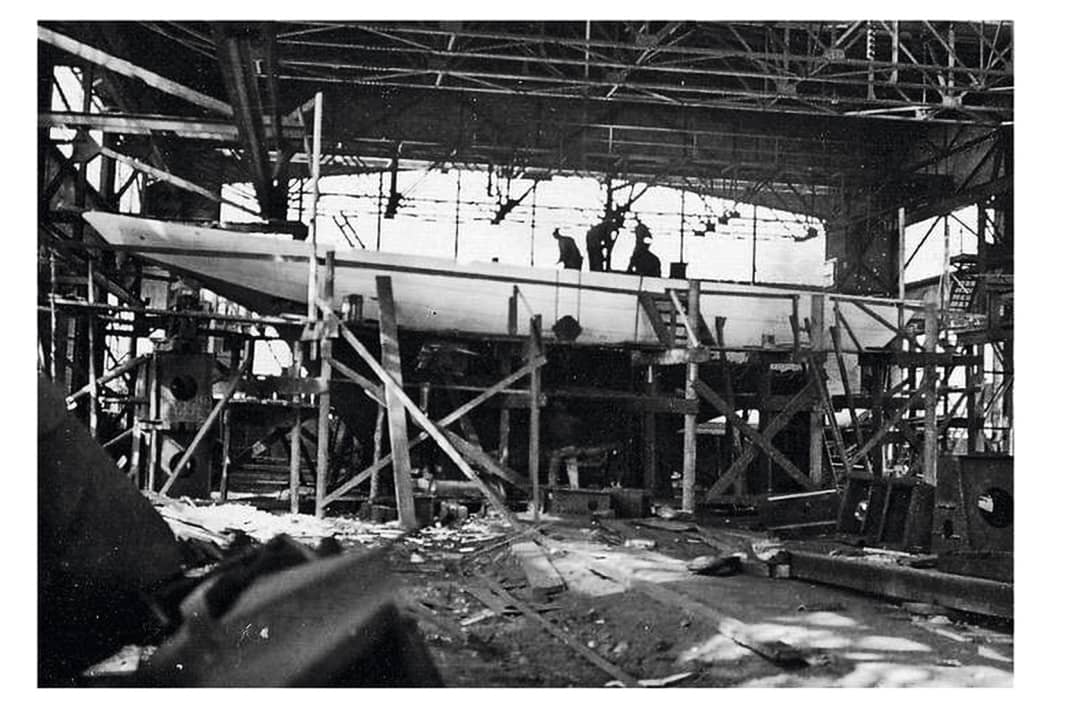




Restoration as a mammoth task
Putting the Hochseeyawl back into service year after year is a task that regularly pushes the ASV to its limits. And in addition to care and maintenance, many changes are made to the yacht as part of the endeavours to preserve her.
The wooden wheelhouse is replaced by a steel replica. The ship is rebuilt below deck. The wooden deck gives way to a 4.5 tonne steel deck. The outer skin is planked with new steel plates above the waterline, the dents caused by the welding work characterise the appearance of the "Peter von Danzig" from then on, as do the increasingly high water pass, the bow and stern pulpit made of galvanised steel and aluminium trees.
Since his first day on board, von Reibnitz has also been busy transforming the ocean-going yacht, renamed "Peter von Seestermühe", back into a piece of jewellery. Initially, neither he nor the ship was believed to be capable of this. It had lost too much of its original appearance.
More elegant than ever before
Today, the "Peter" has a more elegant appearance than ever before: the chart house, coamings and companionways are once again made of wood, teak decks, plastered outer skin, wooden beams and now also the classically elegant saloon.
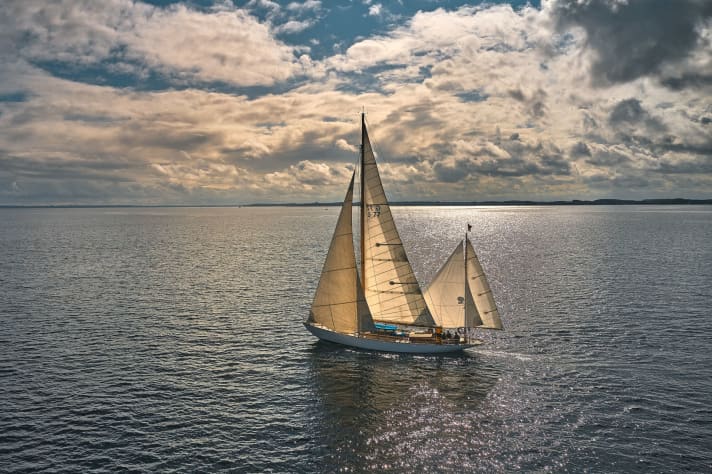
As after construction, a second companionway in front of the wheelhouse now leads directly into the saloon. The aft deck can be used separately for lounging and chart work. And once again, the operation has helped in the constant battle against the ship's weight, which has grown steadily over the decades.
In terms of sailing, von Reibnitz seamlessly continues the tradition of his yacht. Towards the end of the 1992 season, he has the ship ready for sea again and has been in constant use ever since. The summer of 1993 marked the start of his business with charter guests, whom he did not simply take to sea. The sailors themselves form the crew and are deployed according to their growing skills along the way.
Traditional seamanship is required on board
In the summer of 1994, the "Peter von Seestermühe" set sail for the first time on the Atlantic Rally for Cruisers, which has since taken it to the Caribbean every other winter. The ship has now completed around two thirds of its Atlantic voyages under its current owner. In the summer of 1999, the Lofoten Islands were his destination, and since then he has travelled to the west Norwegian coast summer after summer. When a North Atlantic regatta was organised again in 2003, the "Peter" was at the start, as it was again in 2007. And since 2005, the ship has also visited its old home port of Gdansk several times.
As in the past, the craft of traditional seamanship is mastered and passed on on board, equipment is maintained and repaired underway, harbour manoeuvres are often sailed under sail, even since the engine was installed, and value is placed on good food and friendly interaction. When old ships like the "Peter" experienced a renaissance in the mid-1990s, von Reibnitz was there and his "Peter" has been competing in the classic regattas on his home turf ever since. And even though he prefers to go cruising and look at his anchored yacht from the campfire on the beach after a day of motorless sailing, the "Peter" is always successful at regattas, because after all the attention it has received, it is once again one of the fastest ships of its kind.
And so owner Christoph von Reibnitz and his "Peter von Seestermühe" have long since become just as much of an institution as the yacht was as the ASV's "Peter von Danzig". Countless sailors have signed on and signed off, and friendships have been made for life. The North Atlantic Regatta from West to East in 2003 also brought the owner full circle to the ship that had become a ship in its year of construction. But, says von Reibnitz: "How good it is that circles have no ends."
Technical data "Peter von Seestermühe"
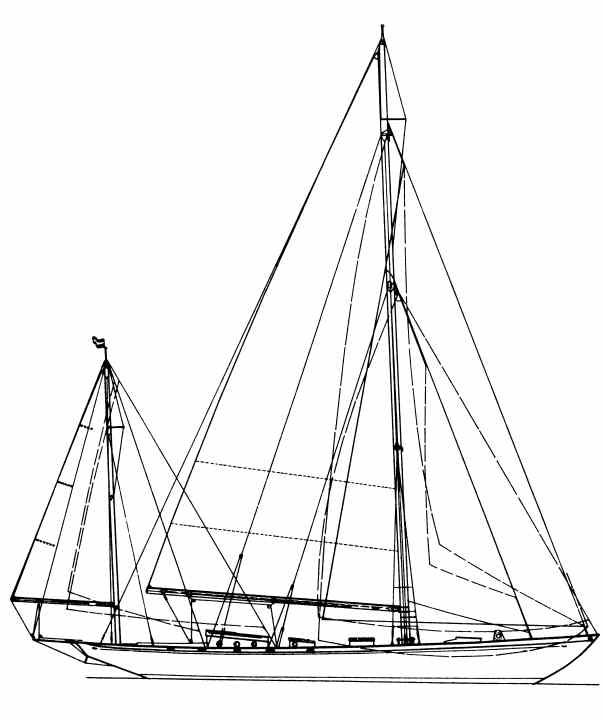
- Designer Henry Gruber
- Danziger Werft shipyard
- Year of construction 1936
- Total length 17.90 m
- Waterline length 13.00 m
- Width 4.16 m
- Draught 2.70 m
- Displacement 30.0 tonnes
- Sail area downwind 147.0 square metres
- Ballast 9.8 tonnes
- Engine (Yanmar) 100 hp
- www.peter-von-seestermuehe.de

